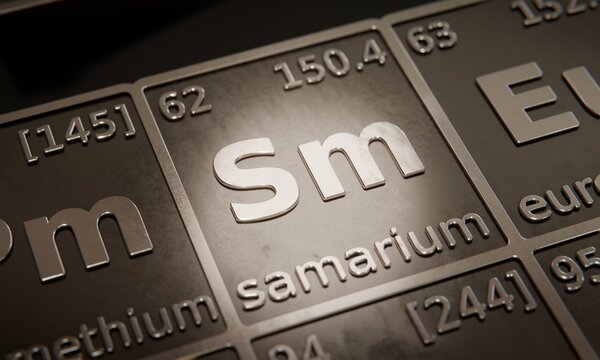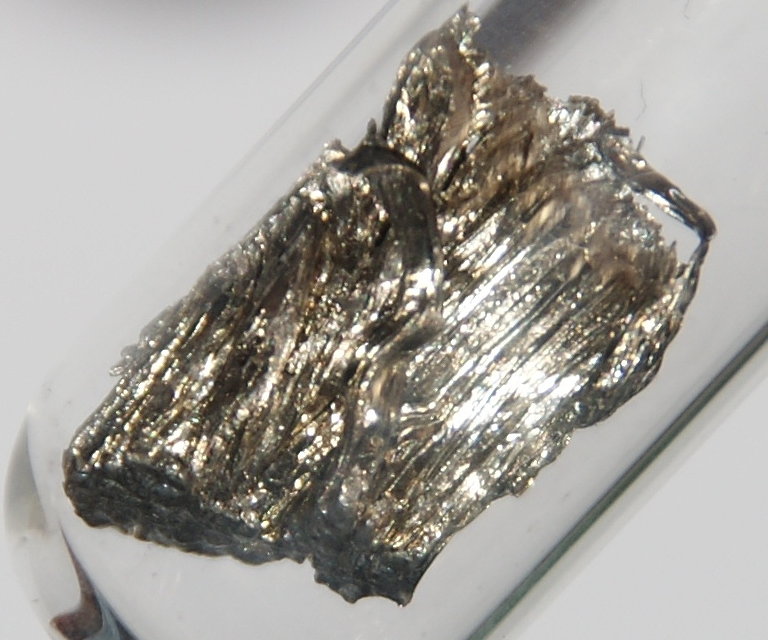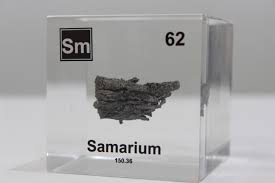Identity.
Samarium, element number 62, is a soft, silvery metal found alongside
its fellow lanthanides. Though named after a mineral, it wasn't truly
isolated until 1879. Stable in air but prone to tarnishing, it shines
brightly when freshly cut but ignites only at high temperatures.
Extracted from various minerals, its claim to fame lies in
super-strong permanent magnets and specialized glass and ceramics.
While not truly "rare," its unique properties make it a valuable
player in modern technology.
Atomic Structure:
The nucleus consists of 62 protons (red) and 88 neutrons (orange). 62
electrons (white) successively occupy available electron shells
(rings). Samarium is a lanthanide in period 6, and the f-block of the
periodic table. It melts at 1072 degrees Celsius.
History.
he story begins in 1853, when Swiss chemist Jean Charles Galissard de
Marignac noticed distinct spectral lines in a material called
"didymium." These lines hinted at a hidden element, but it took almost
30 years to unveil it.
Enter French chemist Paul-Émile Lecoq de Boisbaudran, who, in
1879, successfully isolated the mystery element from the mineral
samarskite (named after a Russian official). Fun fact: samarium
holds the distinction of being indirectly named after a living
person!
Lecoq's discovery didn't end there. Soon after, in 1901, another
chemist, Eugène-Antole Demarçay, realized Lecoq's samarium wasn't
pure. He further separated it, revealing another element –
europium. This highlighted the complex nature of the "rare earths"
and paved the way for further discoveries.
Usage.
Samarium packs a punch in various ways. One key role is in
high-performance magnets: the heat-resistant samarium-cobalt variety
fuels your headphones, guitar pickups, and even helps guide missiles
with precision. Additionally, a different isotope acts as a shield in
nuclear reactors, absorbing neutrons to ensure safety and control. And
the fight against cancer gets a boost from another isotope, targeting
and destroying malignant cells in various forms. So, while you might
not see samarium shining bright, its hidden applications impact your
daily life and beyond.
-
Magnet Mastermind: Samarium shines in creating powerful
permanent magnets. These samarium-cobalt magnets boast high
resistance to demagnetization, even at scorching temperatures.
Find them in your headphones, electric guitar pickups, and even
precision-guided weapons!
-
Nuclear Hero: The isotope samarium-149 plays a crucial role
in nuclear reactors. Acting as a neutron absorber, it helps
control the chain reaction, contributing to safe and efficient
energy production.
-
Medical Marvel: Another isotope, samarium-153, takes center
stage in the fight against cancer. Administered as samarium
lexidronam, it targets and destroys cancer cells in various
cancers like lung, prostate, and breast.
Some of the benefits of using Samarium are:
-
Samarium-cobalt magnets offer unparalleled strength and heat
resistance, found in everything from high-fidelity headphones to
high-tech machinery. Their durability and performance surpass
other commonly used magnets.
-
Samarium-153 isotope delivers targeted radiation therapy for
specific cancers, including prostate and breast. This minimally
invasive approach minimizes side effects compared to traditional
methods, improving patient quality of life.
-
Samarium-149 acts as a "control rod" in nuclear reactors,
absorbing excess neutrons to regulate the fission process. This
ensures stable and safe operation, minimizing the risk of
accidents.
-
Samarium finds its way into specialized glass and ceramics, used
in lasers, optical filters, and high-performance electronics. Its
unique properties enable breakthroughs in fields like
telecommunications and medical imaging.
Sources.
While not exactly "rare," samarium isn't found pure in nature.
Instead, it hides within minerals like monazite and bastnasite,
primarily mined in China, the United States, Brazil, India, Australia,
and Sri Lanka. Extracting it involves complex processes like ion
exchange and solvent extraction, yielding the silvery metal we use in
various applications. So, next time you rock out to your headphones or
benefit from targeted cancer treatment, remember, a hidden treasure
called samarium plays a crucial role.
Properties.
Magnet Mastermind Samarium shines in creating extremely
powerful permanent magnets. These samarium-cobalt magnets resist
demagnetization even at high temperatures, making them ideal for
headphones, electric guitar pickups, and even precision-guided
weapons.
Spectral Singnature: One of its defining characteristics is
its distinct spectral lines. These unique patterns of light absorption
helped scientists identify and differentiate samarium from other
lanthanides in the early days of its discovery.
Nuclear Hero: Certain isotopes of samarium possess special
nuclear properties. Samarium-149 acts as a neutron absorber in nuclear
reactors, ensuring safe and efficient operation by controlling the
chain reaction.


